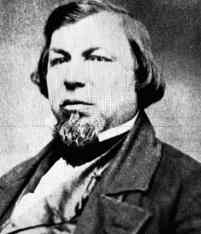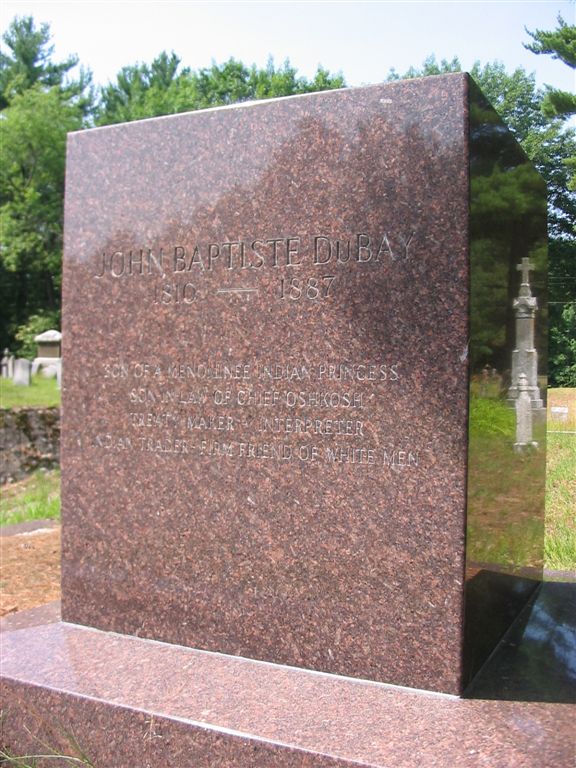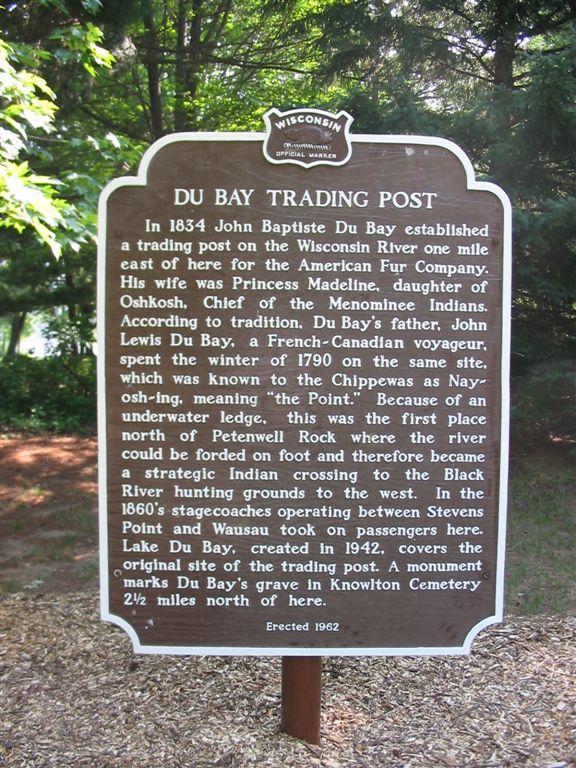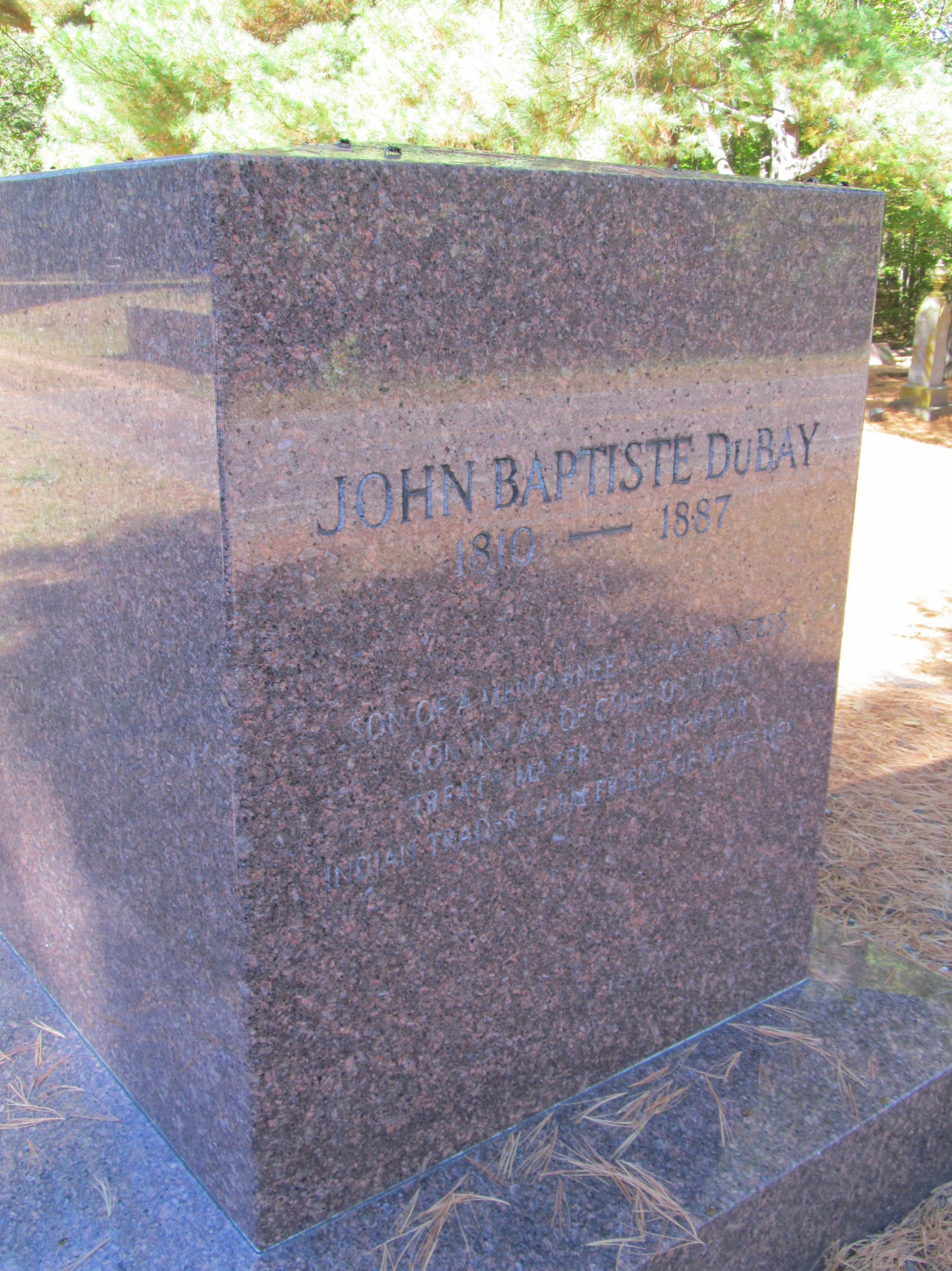Son-in-Law of Chief Oshkosh •
Treaty-Maker • Interpreter
Indian Trader • Firm Friend of White Men
...........................................................
John Baptiste DuBay was born in 1810 or a few years earlier, probably in Green Bay (Fort Howard), the son of a French-Canadian man and a Menominee Indian woman (reportedly the daughter of Chief Pewatenot). He married Princess Madelaine, daughter of Chief Oshkosh, and was present, occasionally as an interpreter, at some of the important negotiations between American Indians and the United States government. He had worked for John Jacob Astor's American Fur Company, the most powerful business concern in territorial Wisconsin.
As early as 1830 the name DuBay began appearing on maps of Wisconsin territory. An 1836 map shows Prairie Du Bay settlement located northeast of the present town of Boscobel. A map done by Increase Lapham in 1855 shows Du Bay Point settlement, between Stevens Point and Wausau, as "Du Bay's." Today the name DuBay still appears on the map of Wisconsin, one of the few reminders we have of a colorful and controversial character in the early history of what is now the state of Wisconsin: Jean Baptiste DuBay --- trader, lumberman, steamboat- and stage-line owner, mill operator, legislative lobbyist, and linguist. Referred to as the Daniel Boone of the north country, DuBay was a prosperous businessman widely known throughout the Northwest.
According to the January 15, 1887, edition of the Stevens Point Journal, John Baptiste DuBay died on January 11, 1887, at his home on the Wisconsin River.
Source: excerpts from digicoll.library.wisc.edu
...........................................................
John B. DuBay who died at Hutch-
inson, Marathon county, this week,
was born in Green Bay in 1810. He
was a noted man with the Indians in
early days and took part in the Black
Hawk war.
— Oshkosh Daily Northwestern; Saturday, January 15, 1887
Death of John B. DuBay
The death of the above named
well known, and in some respects
remarkable individual, took place at
his home on the Wisconsin river
above this city last Tuesday. He
had been gradually failing for some
time, but was really sick only about
two weeks. The funeral took place
on Thursday, with interment in the
Knowlton cemetery.
In the death of DuBay, probably
the oldest person born within the
territory now comprising the State
of Wisconsin has passed away. He
was born at Green Bay in 1810, and
therefore when the Territory of Wis-
consin was organized he was 26
years of age; when it became one of
the States of the Union he had
attained the age of 38. A portion of
his earlier years, however, were
spent in Michigan, where he was
engaged in trading with the Indians,
and he claimed to have built the first
house on the Kalamazoo river, near
the site of the present city of that
name. He afterwards served as in-
terpreter for Gov. Dodge, Wiscon-
sin's first territorial Governor, and
for many years thereafter was in-
timately associated in one capacity
and another, with nearly all the
men whose names are so prominently
associated with our early history.
For five years he had charge of the
American Fur Company's interests
on the headquarters of the Chippewa,
where the Company had at that time
maintained a trading post for about
100 years. The first saw mill ever
built at Chippewa Falls was in pur-
suance of an arrangements made by
DuBay with the Indians. He at one
time had a claim at Fort Winnebago,
upon which a party, under the lead-
ership of one Reynolds, undertook
to build a mill. During the absence
of DuBay on a hunting excursion,
they put up the frame, which, when
he returned at night, he proceeded
to pull down. In the trouble that
followed DuBay shot and killed Rey-
nolds. DuBay gave himself up and
was taken to jail, where a mob gath-
ered to lynch him. The latter were
told by the sheriff that he had armed
DuBay, and they had better go
away, which they did. He was
tried at Madison, being defended by
Harlow S. Orton, at present an
associate justice of our Supreme
Court, and Hon. Moses M. Strong,
and acquitted. He had lived on the
place where he died for many years,
and in the early history of this coun-
try was one of the best known men
in it. During his latter years he
was supported by his children, but
he had handled a great many
thousand dollars worth of goods,
and there are people who can remember
when he used to drive the finest team
between Wausau and Portage.
— The Stevens Point Journal; Saturday, January 15, 1887
Son-in-Law of Chief Oshkosh •
Treaty-Maker • Interpreter
Indian Trader • Firm Friend of White Men
...........................................................
John Baptiste DuBay was born in 1810 or a few years earlier, probably in Green Bay (Fort Howard), the son of a French-Canadian man and a Menominee Indian woman (reportedly the daughter of Chief Pewatenot). He married Princess Madelaine, daughter of Chief Oshkosh, and was present, occasionally as an interpreter, at some of the important negotiations between American Indians and the United States government. He had worked for John Jacob Astor's American Fur Company, the most powerful business concern in territorial Wisconsin.
As early as 1830 the name DuBay began appearing on maps of Wisconsin territory. An 1836 map shows Prairie Du Bay settlement located northeast of the present town of Boscobel. A map done by Increase Lapham in 1855 shows Du Bay Point settlement, between Stevens Point and Wausau, as "Du Bay's." Today the name DuBay still appears on the map of Wisconsin, one of the few reminders we have of a colorful and controversial character in the early history of what is now the state of Wisconsin: Jean Baptiste DuBay --- trader, lumberman, steamboat- and stage-line owner, mill operator, legislative lobbyist, and linguist. Referred to as the Daniel Boone of the north country, DuBay was a prosperous businessman widely known throughout the Northwest.
According to the January 15, 1887, edition of the Stevens Point Journal, John Baptiste DuBay died on January 11, 1887, at his home on the Wisconsin River.
Source: excerpts from digicoll.library.wisc.edu
...........................................................
John B. DuBay who died at Hutch-
inson, Marathon county, this week,
was born in Green Bay in 1810. He
was a noted man with the Indians in
early days and took part in the Black
Hawk war.
— Oshkosh Daily Northwestern; Saturday, January 15, 1887
Death of John B. DuBay
The death of the above named
well known, and in some respects
remarkable individual, took place at
his home on the Wisconsin river
above this city last Tuesday. He
had been gradually failing for some
time, but was really sick only about
two weeks. The funeral took place
on Thursday, with interment in the
Knowlton cemetery.
In the death of DuBay, probably
the oldest person born within the
territory now comprising the State
of Wisconsin has passed away. He
was born at Green Bay in 1810, and
therefore when the Territory of Wis-
consin was organized he was 26
years of age; when it became one of
the States of the Union he had
attained the age of 38. A portion of
his earlier years, however, were
spent in Michigan, where he was
engaged in trading with the Indians,
and he claimed to have built the first
house on the Kalamazoo river, near
the site of the present city of that
name. He afterwards served as in-
terpreter for Gov. Dodge, Wiscon-
sin's first territorial Governor, and
for many years thereafter was in-
timately associated in one capacity
and another, with nearly all the
men whose names are so prominently
associated with our early history.
For five years he had charge of the
American Fur Company's interests
on the headquarters of the Chippewa,
where the Company had at that time
maintained a trading post for about
100 years. The first saw mill ever
built at Chippewa Falls was in pur-
suance of an arrangements made by
DuBay with the Indians. He at one
time had a claim at Fort Winnebago,
upon which a party, under the lead-
ership of one Reynolds, undertook
to build a mill. During the absence
of DuBay on a hunting excursion,
they put up the frame, which, when
he returned at night, he proceeded
to pull down. In the trouble that
followed DuBay shot and killed Rey-
nolds. DuBay gave himself up and
was taken to jail, where a mob gath-
ered to lynch him. The latter were
told by the sheriff that he had armed
DuBay, and they had better go
away, which they did. He was
tried at Madison, being defended by
Harlow S. Orton, at present an
associate justice of our Supreme
Court, and Hon. Moses M. Strong,
and acquitted. He had lived on the
place where he died for many years,
and in the early history of this coun-
try was one of the best known men
in it. During his latter years he
was supported by his children, but
he had handled a great many
thousand dollars worth of goods,
and there are people who can remember
when he used to drive the finest team
between Wausau and Portage.
— The Stevens Point Journal; Saturday, January 15, 1887
Family Members
Advertisement
Explore more
Sponsored by Ancestry
Advertisement






